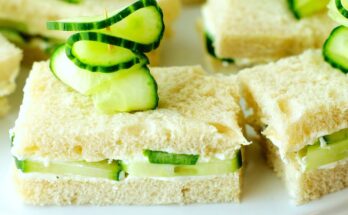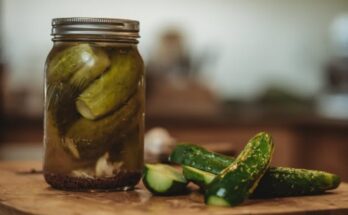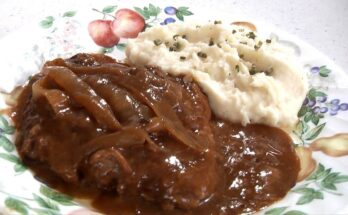Cuban Sandwich Recipe: The Cuban sandwich, also known as “Cubano,” is a mouthwatering pressed sandwich packed with bold flavors. At its heart, it’s a harmony of slow-roasted pork, ham, Swiss cheese, tangy pickles, and mustard layered between crispy Cuban bread. What makes it unique is the combination of textures: the crunch from the pressed bread, the creaminess of melted cheese, the savory layers of meat, and the zing from mustard and pickles. Unlike your ordinary ham and cheese, a Cuban sandwich is a symphony of flavors with every bite. It’s hearty, satisfying, and perfect whether you’re making it for lunch, dinner, or even as a party snack.
Origins and History of the Cuban Sandwich
The Cuban sandwich has an interesting story tied to Cuban immigrants in Florida. It is believed to have originated in either Tampa or Miami in the late 1800s or early 1900s. In Tampa, cigar factory workers from Cuba would bring their food traditions, and the sandwich became a staple meal. Miami also claims the title since Cuban exiles made it famous there, leading to heated debates about where it was truly invented. The Tampa version even adds salami, reflecting the influence of Italian immigrants in the area. Over time, the Cuban sandwich became an iconic dish, celebrated at food festivals and restaurants worldwide.
Why This Sandwich is Loved Worldwide
The Cuban sandwich isn’t just food—it’s an experience. Its balance of salty ham, tender pork, sharp mustard, tangy pickles, and gooey Swiss cheese makes it irresistible. The pressed bread elevates it, turning an ordinary sandwich into a crunchy, melty delight. It’s versatile too—you can serve it at casual gatherings, make it as a quick weeknight meal, or impress guests at a party. Plus, it has become a cultural symbol, representing the fusion of Cuban and American culinary traditions. With its simple ingredients and unforgettable taste, the Cuban sandwich has secured its spot as a global favorite.
Ingredients You’ll Need
Essential Ingredients for Authentic Cuban Sandwich
To make a truly authentic Cuban sandwich, you’ll need:
- Cuban bread (or a suitable substitute like French or Italian bread)
- Yellow mustard
- Thinly sliced dill pickles
- Swiss cheese
- Roast pork (slow-cooked or leftover)
- Sliced ham (preferably smoked or honey ham)
These ingredients come together to create the authentic flavors that define the Cuban sandwich. The key is balance—too much of one ingredient can overpower the rest. For instance, the mustard should enhance the sandwich, not dominate it, while the pickles should add a zesty crunch without overwhelming the savory meats.
Recommended Bread for the Perfect Texture
Bread is the backbone of the Cuban sandwich. Authentic Cuban bread is long, white, and slightly crusty on the outside but soft inside. If you can’t find Cuban bread, opt for French bread or Italian loaf. Avoid sourdough or overly chewy bread, as they change the flavor profile. The bread needs to be sturdy enough to handle pressing but soft enough to bite into comfortably. A good tip is to slightly warm the bread before assembling—it makes it easier to press and gives it that golden crunch.
Choosing the Right Meat and Cheese
The meat is what makes the Cuban sandwich hearty and flavorful. Traditional recipes use mojo-marinated roast pork, which is slow-cooked until tender. Combine this with sweet or smoky ham for layers of flavor. The cheese should always be Swiss—it melts beautifully, providing creaminess that balances the tang of mustard and pickles. Some people experiment with cheddar or provolone, but Swiss is the classic choice. Remember: the quality of meat and cheese directly affects how good your Cuban sandwich tastes.
Optional Add-ons and Variations
While the classic Cuban sandwich is perfect as it is, you can play around with variations. In Tampa, salami is often added for an extra kick. Some people like to swap the mustard for aioli or add spicy pickles for more heat. If you’re vegetarian, roasted veggies and plant-based cheese make great substitutes. For a modern twist, try using turkey, chicken, or even smoked brisket. Just keep the balance of flavors intact—the key is layering ingredients thoughtfully so that no single flavor overpowers the rest.
Tools and Equipment You’ll Need
Panini Press or Grill Pan
The press is what transforms this sandwich from good to legendary. A panini press is the best tool, as it evenly flattens and crisps the sandwich. If you don’t have one, a heavy cast-iron skillet can work. Simply place another skillet or a foil-wrapped brick on top to mimic the press. The goal is to get that perfect golden crust while melting the cheese inside.
Knives, Cutting Boards, and Spatulas
A sharp knife is essential for slicing the bread and meats evenly. Use a sturdy cutting board to assemble the sandwich, and a spatula to handle it once grilled. Good tools make the process easier and help you create a restaurant-quality sandwich at home.
Alternatives if You Don’t Have a Press
If you lack a panini press, don’t worry—you can still achieve excellent results. Heat a heavy skillet, place the sandwich inside, and press it down with another skillet or a brick wrapped in foil. Cook it on medium heat to avoid burning the bread before the cheese melts. This method works just as well, though you’ll need to flip the sandwich halfway through to grill both sides.
Step-by-Step Guide to Making a Cuban Sandwich
Step 1: Preparing the Bread
Start by slicing your Cuban bread horizontally. Make sure the cut is even so the sandwich presses neatly. If your bread is too thick, remove a little of the soft interior to prevent it from being too bready. Lightly butter the outside of the bread for extra crispiness.
Step 2: Spreading the Mustard
Generously spread yellow mustard on both sides of the bread. This tangy base is what makes a Cuban sandwich unique. Don’t swap it for mayo—authentic Cuban sandwiches always use mustard.
Step 3: Layering the Ingredients
Now comes the fun part—layering! Start with slices of ham, followed by roast pork, Swiss cheese, and dill pickles. The order helps balance the flavors and ensures even melting. Keep the layers even and don’t overload the sandwich, or it will be hard to press.
Step 4: Pressing and Grilling the Sandwich
Heat your panini press or skillet. Place the sandwich inside, press it down firmly, and grill until the bread is golden and crispy, and the cheese has fully melted—usually 5–7 minutes.
Step 5: Slicing and Serving
Once done, remove the sandwich and let it rest for a minute. Slice it diagonally for the classic look, and serve hot with your favorite sides.
Tips and Tricks for the Perfect Cuban Sandwich
Getting the Right Crunch
One of the Cuban sandwich’s most irresistible qualities is its crunch. That golden, crispy crust sets it apart from regular sandwiches. To achieve this, buttering the outside of the bread is key. Some cooks prefer brushing the bread with a little olive oil, but butter gives it a richer flavor and helps the crust brown evenly. The press also plays a big role—steady, even pressure ensures the bread crisps without burning. Keep your heat at medium; if it’s too high, the outside will scorch before the cheese inside melts. If you want an extra-crunchy finish, sprinkle a touch of Parmesan cheese on the outside of the bread before pressing. It adds a lovely texture and a nutty note to every bite.
Balancing the Flavors
A Cuban sandwich is all about harmony. Every ingredient has a role: the mustard provides tang, the pickles add acidity, the cheese offers creaminess, and the meats deliver savory richness. If one ingredient overpowers the others, the sandwich feels off balance. For example, too many pickles will make it overly sour, while too much mustard can drown out the cheese. The trick is moderation—think of it as building a layered flavor profile rather than piling on as much as possible. Also, warming the roast pork slightly before layering helps the cheese melt more evenly and prevents a cold center.
Common Mistakes to Avoid
Many people go wrong by using the wrong bread or skipping the press. Regular sandwich bread won’t cut it—it’s too soft and flimsy to hold up under pressure. Another mistake is overstuffing the sandwich. While tempting, adding too much meat makes it bulky and prevents the cheese from melting properly. Some also substitute mayonnaise for mustard, but that completely changes the character of the sandwich. Finally, don’t rush the pressing process. Give the sandwich enough time to crisp up and let the flavors meld. Patience really pays off when making a Cuban sandwich.
Serving Suggestions and Pairings
Side Dishes That Go Well with Cuban Sandwich
The Cuban sandwich is hearty enough to stand alone, but pairing it with the right sides makes the meal even better. Classic choices include:
- Plantain chips (crispy and slightly sweet, balancing the savory sandwich)
- Yuca fries (a Cuban favorite that’s crunchier than potato fries)
- Black bean soup (hearty and comforting, perfect for dipping)
- Coleslaw (adds freshness and crunch)
If you want something light, a simple mixed salad with citrus dressing pairs wonderfully with the richness of the sandwich. For a more indulgent meal, pair it with fries or onion rings for that classic diner feel.
Best Drinks to Enjoy with It
A Cuban sandwich deserves an equally refreshing drink. Traditional Cuban meals often include Cuban coffee (cafecito), but for a sandwich, you’ll want something cool and crisp. Lime soda, iced tea, or a cold beer are popular choices. If you want to stick with Cuban tradition, pair it with a mojito or a Cuba Libre (rum and cola with lime). For non-alcoholic options, tropical juices like mango or pineapple add a fruity contrast to the sandwich’s salty notes.
Presentation Tips for Parties and Gatherings
Cuban sandwiches are perfect for entertaining because they’re easy to make in batches. For parties, prepare several sandwiches, press them, and then slice each into smaller portions. Arrange them on a wooden board with sides like plantain chips and small bowls of dipping sauces. You can also wrap individual halves in parchment paper for a casual, street-food vibe. Garnish with fresh herbs or lime wedges to add a touch of color. The key is to make them easy to grab and eat, keeping that irresistible crunch intact until the very last bite.
Variations of the Cuban Sandwich
Miami vs. Tampa Style Cuban Sandwich
One of the biggest debates in Cuban cuisine is where the Cuban sandwich truly originated—Miami or Tampa. Each city has its own version.
- Miami style is considered the purist version: roast pork, ham, Swiss cheese, pickles, mustard, and Cuban bread.
- Tampa style adds salami, reflecting the influence of Italian immigrants in Ybor City, Tampa’s historic district. This addition gives the sandwich a slightly spicier and more robust flavor.
Both versions are delicious, and which one you prefer comes down to personal taste. If you like a straightforward, traditional flavor, go Miami. If you want a heartier, slightly bolder version, Tampa’s is the way to go.
Creative Twists and Modern Versions
Chefs around the world have experimented with the Cuban sandwich, creating unique versions while keeping its spirit intact. Some add barbecue sauce to the pork for a smoky twist, while others replace the ham with turkey or pastrami. Fusion versions even use tortillas to create Cuban quesadillas or swap bread for waffles to make Cuban melts. Another popular twist is the breakfast Cuban sandwich, which includes scrambled eggs or a fried egg along with the traditional ingredients. These variations show just how versatile the Cuban sandwich can be without losing its essence.
Vegetarian and Vegan Alternatives
Even if you don’t eat meat, you can still enjoy a Cuban sandwich. For a vegetarian version, replace the pork and ham with roasted vegetables like eggplant, zucchini, or mushrooms. Vegan versions swap out the cheese with plant-based alternatives and use vegan deli slices or jackfruit “pork.” Mustard and pickles remain the same, giving that authentic tangy flavor. Toasted bread still provides the crunch, so you get the satisfying texture of a traditional Cuban sandwich without the meat.
Storing and Reheating Leftovers
How to Store Properly
If you’ve made extra sandwiches or couldn’t finish one, storage is simple. Wrap the sandwich tightly in foil or plastic wrap and keep it in the refrigerator. This prevents it from drying out and keeps the flavors intact. Ideally, eat it within 2–3 days for the best taste.
Best Reheating Methods
To reheat a Cuban sandwich, avoid the microwave—it makes the bread soggy. Instead, place it in a skillet or oven. In the oven, wrap it in foil and bake at 350°F for about 10–15 minutes. If you want to revive the crispiness, unwrap the foil for the last few minutes. On the stovetop, heat it in a skillet over medium heat, pressing it down gently until the cheese melts again and the bread crisps up.
How Long It Lasts
A Cuban sandwich tastes best fresh, but leftovers can last up to 3 days in the fridge. If you want to keep them longer, wrap them well in foil and freeze them. They can last for about a month in the freezer. When reheating from frozen, let them thaw in the fridge overnight before reheating with one of the above methods.
Nutritional Information
Calories and Macronutrients
A Cuban sandwich is deliciously indulgent, but it’s also fairly calorie-dense. On average, a full-sized Cuban sandwich contains around 700–900 calories, depending on the size and specific ingredients used. The bread contributes a good portion of carbohydrates, usually around 80–100 grams. The pork and ham deliver a hefty amount of protein—anywhere from 30–40 grams—while the cheese and meats also provide fat, usually about 25–35 grams per serving. The mustard and pickles add minimal calories but provide essential flavor. Because it’s pressed and grilled with butter, there are extra fats to consider as well. In short, this isn’t exactly a “light” meal, but it is filling and satisfying enough to keep you energized for hours.
Health Benefits and Concerns
While the Cuban sandwich is indulgent, it does have some nutritional benefits. The pork and ham are rich in protein, supporting muscle repair and energy. Swiss cheese adds calcium and protein, while pickles contribute probiotics and help with digestion. However, the sandwich is also high in sodium and saturated fat. Eating it too often could raise cholesterol levels or contribute to weight gain. Portion control is important here—enjoying a Cuban sandwich once in a while won’t hurt, but it shouldn’t become an everyday meal. For those watching their diet, making smaller portions or splitting a sandwich with someone else can help.
Making It a Bit Healthier
You don’t have to sacrifice flavor to make a healthier Cuban sandwich. Try using whole-grain bread instead of white Cuban bread to add fiber. Opt for lean pork tenderloin instead of fattier cuts, and choose lower-sodium ham to cut back on salt. Switching to reduced-fat Swiss cheese or using less of it can lower the saturated fat. Instead of butter, lightly brush the bread with olive oil before pressing—it crisps beautifully while being a bit healthier. For sides, pair the sandwich with a fresh salad instead of fries. These small tweaks let you enjoy the authentic taste of a Cuban sandwich without feeling guilty afterward.
FAQs about Cuban Sandwich Recipe
1. Can I make a Cuban sandwich without a press?
Yes! If you don’t have a press, simply use a heavy skillet and place another pan or a foil-wrapped brick on top to flatten the sandwich as it cooks. Flip it halfway to ensure both sides get golden and crispy.
2. What’s the difference between a Cuban sandwich and a regular ham and cheese?
A regular ham and cheese is usually just ham, cheese, and bread. A Cuban sandwich adds roast pork, pickles, mustard, and is pressed for a crunchy texture, making it much richer and more flavorful.
3. Can I use turkey instead of pork?
Absolutely! While pork is traditional, turkey is a leaner substitute that still works well with the other ingredients. The flavor will be slightly different, but still delicious.
4. Is Cuban bread necessary, or can I substitute it?
Cuban bread is ideal, but if you can’t find it, French or Italian bread makes a good substitute. Just avoid sourdough or very dense breads, as they alter the flavor and texture.
5. What’s the best cheese for a Cuban sandwich?
Swiss cheese is the classic choice. It melts perfectly, balances the tangy mustard and pickles, and complements the pork and ham without overpowering them.
Conclusion
The Cuban sandwich is more than just a meal—it’s a piece of history, a cultural icon, and a flavor-packed experience. From its roots in Cuban immigrant communities to its worldwide popularity today, the Cubano continues to win hearts with its crunchy bread, tender pork, smoky ham, tangy pickles, creamy cheese, and mustard zing. Making it at home is easier than you might think, and with the right bread, ingredients, and pressing technique, you can create a restaurant-quality sandwich in your own kitchen. Whether you stick to the classic Miami style, try the Tampa version with salami, or experiment with modern twists, the Cuban sandwich offers endless possibilities. So grab your ingredients, fire up your press, and treat yourself to this timeless sandwich—you’ll understand why it’s loved around the world after just one bite.



